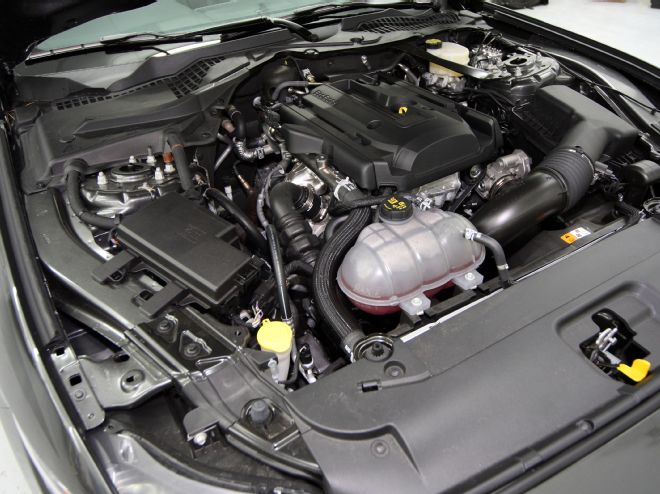
When Ford introduced the EcoBoost engine design, it was easy for Mustang fans to dismiss the strange little engine because it was stuck in the Focus and F-150 trucks. But now, not only is the turbo four EcoBoost an option for the new 2015 Mustang but with 310 hp and 320 lb-ft of torque at the crank, Ford is promoting it as a performance engine. We all still love the mighty V-8, but with ever-increasing fuel economy standards mandated by the government, small displacement engines making power through a turbo (or more!) are going to grow in popularity.
We are also hearing that more and more Mustang fans are coming around to the idea of the 2.3L EcoBoost in their new Stang. After all, the motor is lightweight and revs well, and 310 hp is nothing to sneeze at. Plus, the EcoBoost gained a lot of street cred when Ford chose a twin-turbo V-6 version to power the all-new GT supercar.
But just because the 2.3L turbo four in the new Mustang is surprisingly powerful doesn't mean it can't be made better. Roush Yates Engines, which builds engines for Penske Racing, Roush Fenway Racing, and every other Ford team competing in NASCAR's Sprint Cup Series, is moving into street performance with its Roush Yates Performance Products division. Two of the company's first products are the BoostMAX and PedalMAX systems developed in partnership with JMS. They also developed a line of high-performance sway bars in partnership with Hellwig, so you know their standards are pretty high.
The Roush Yates by JMS BoostMAX is an electronic control system that can increase the boost pressure on EcoBoost engines. We are told the unit for the 2.3L EcoBoost can raise the boost pressure by as much as 5 psi and increase the horsepower by 50 or more. The Roush Yates by JMS PedalMAX, meanwhile, improves on the drive-by-wire stock throttle system by taking out the lag and making it feel much more responsive. Both work by piggybacking a control module on the stock electronics to modify the signal to either the turbo or throttle controls. It is a genius system because it doesn't make any changes to the computer, so it doesn't affect the warranty.
Both the BoostMAX and PedalMAX are pretty stealth and can be installed in about an hour. We documented the process as Roush Yates' chief installer, Jeff "Junior" Paxton, installed both on a new 2015 Mustang. The most difficult part is crawling underneath the dash to plug the PedalMAX unit into the throttle pedal's drive-by-wire system. We love that both are completely stealth, so if you want to keep it to yourself your competition will never know you are packing extra power.
Roush Yates Performance Products and JMS have developed BoostMAX units to work with all of Ford's different EcoBoost engines. The PedalMAX system, however, isn't limited to just EcoBoost engines. It will work with all Ford vehicles from 2011 on up.
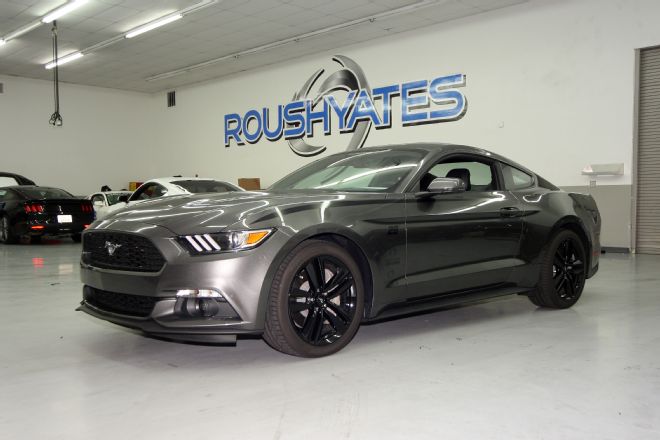
01. The turbocharged four-cylinder EcoBoost Mustang is already pretty potent, but with the addition of Roush Yates Performance Parts' BoostMAX and PedalMAX systems, the car is 54hp stronger and much more fun to drive.
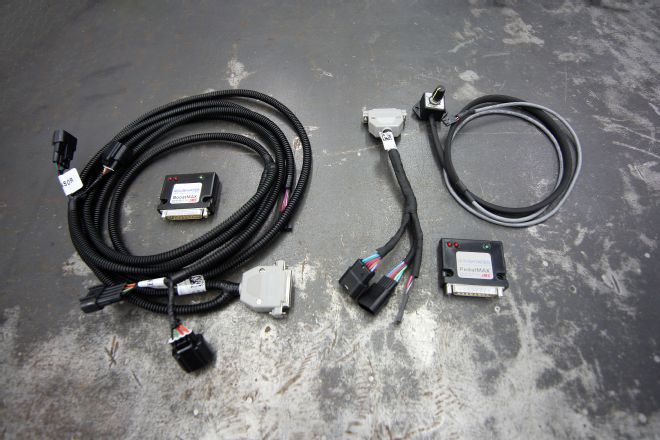
02. The BoostMAX control module and wiring harness is on the left. It also includes a control knob, which is on the upper right side of this photo. In the center is the PedalMAX control module and wiring connector.
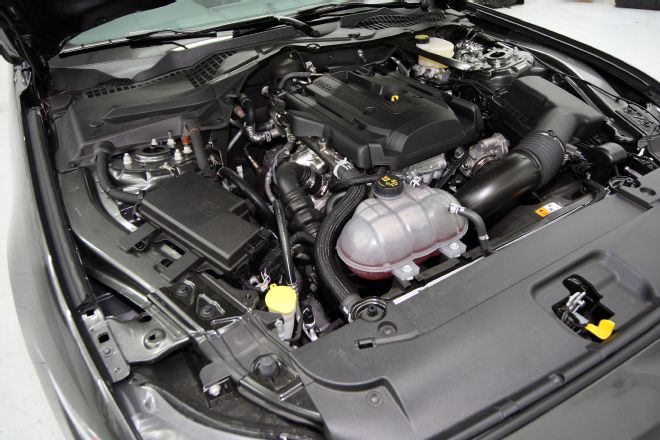
03. Purists may say that a V-8 is the only proper engine for a Mustang, but Ford's turbo four-banger is surprisingly strong and also significantly lighter than the 5.0 Coyote. If you can get even a small increase in power without increasing the weight, the results on the track and street can be dramatic.
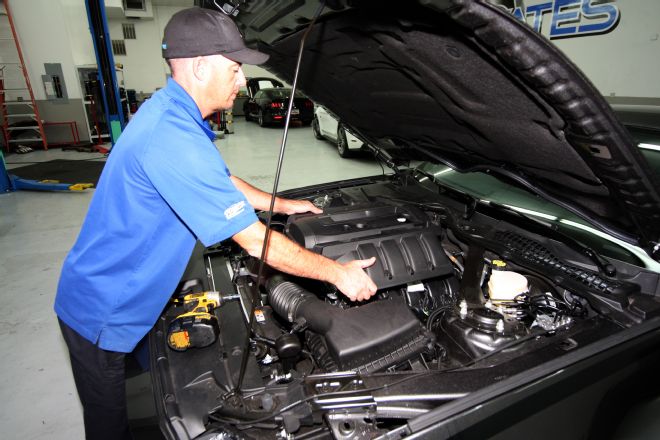
04. Step 1 is to remove the engine cover so that you can access the MAP sensor plug. Roush Yates Performance Parts' chief installer, Jeff "Junior" Paxton, started by disconnecting the battery ground to kill the electrical system.
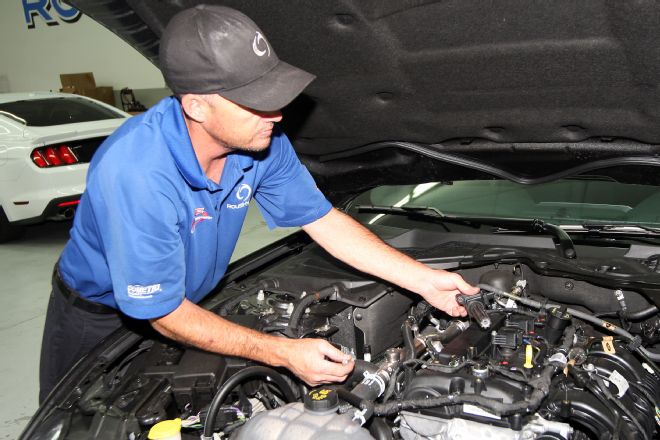
05. As a safety measure, Roush Yates recommends you check and confirm your plug gaps are within the proper tolerance so that they can deal with the added boost pressure. They should be between 0.028 and 0.030 inch. Here, Junior pulls the coil packs to access the spark plugs. Once this task is completed, you are literally done working with the engine.
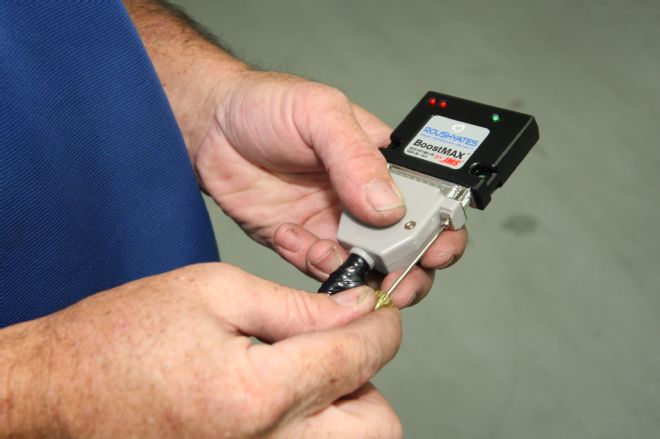
06. The control module is separate from the wiring harness so if it is ever damaged or starts giving problems, it can be removed easily and sent for repair. It uses a multipin connector, and a secure connection is maintained thanks to two screws. Roush Yates even supplies the correct-size screwdriver in the kit.
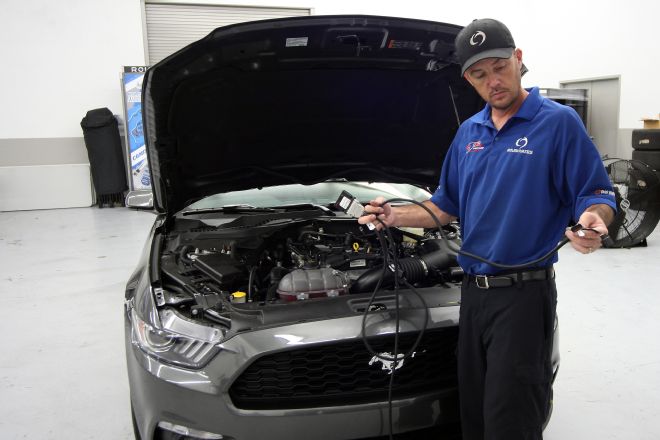
07. All the wires are marked and sleeved, so once it is installed everything looks factory.
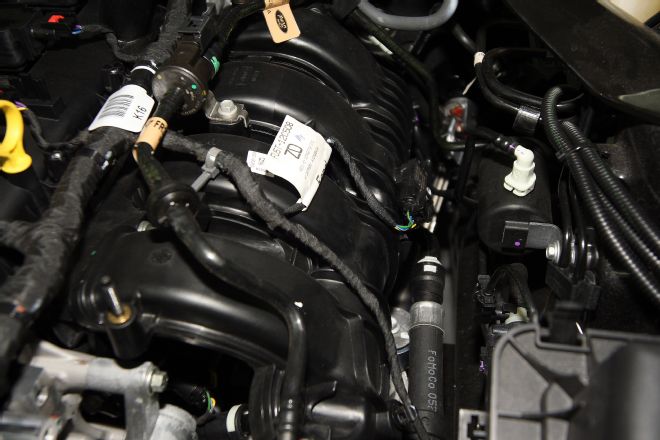
08. The harness includes pigtails to wire into the factory wiring at the manifold absolute pressure (MAP) and the turbo inlet pressure (TIP) sensors. Here you can see the MAP plug near the base of the intake manifold on the left side of the photo.
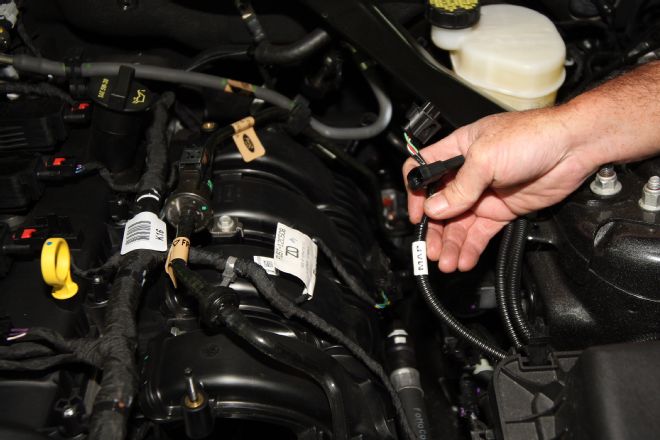
09. Each end of the harness is labeled; here you can see the MAP plugs. Disconnect the OE MAP sensor from the intake manifold.
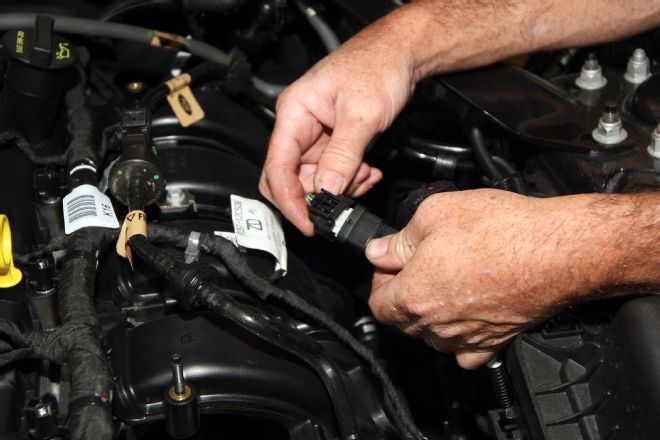
10. Connect the two plugs from the harness in between the OE MAP sensor and the connector. There is a male and a female, so it is impossible to get them backwards; the kit includes zip ties so that you can secure the harness.
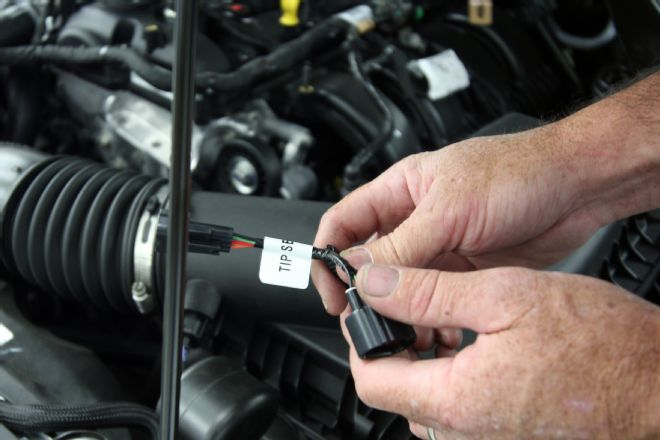
11. Likewise, the plugs for the TIP sensor are also marked, so it's practically impossible to get things mixed up.
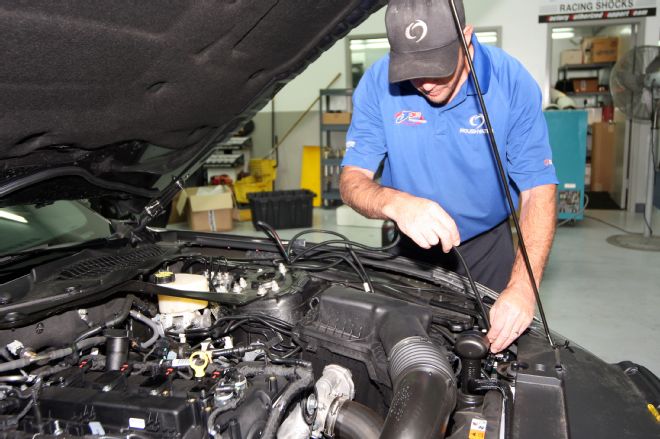
12. The TIP sensor is located just in front of the left front wheel. You can get the wiring harness connections to it by threading the harness down just behind the headlight.
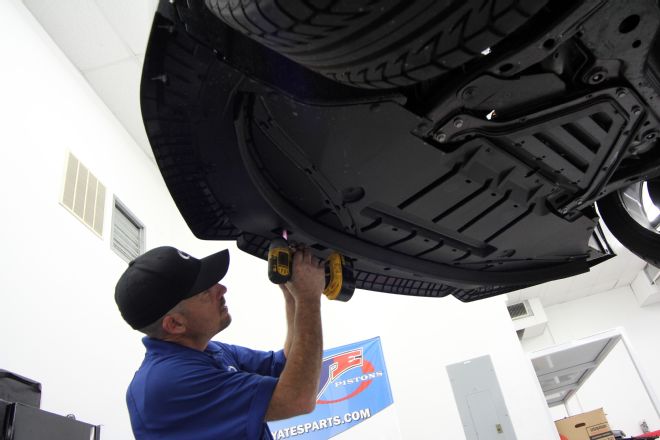
13. To reach the TIP sensor you will need to pull off the plastic cowling underneath the bumper. We put the car on a lift so you could see better, but this step can easily be done with the front of the car on jackstands.
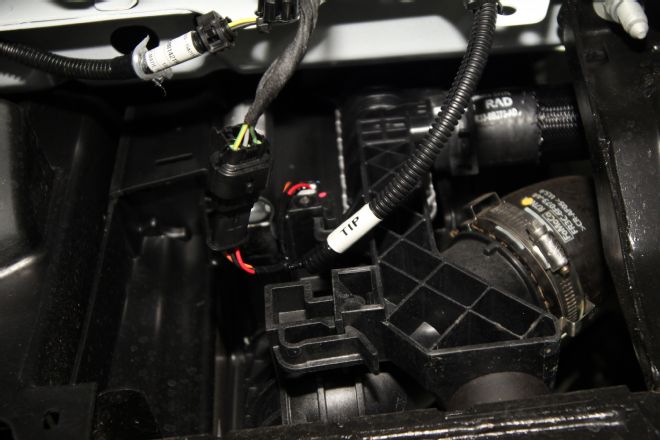
14. Here you can see the harness plugged in between the TIP sensor and the connection on the factory wiring harness. There are lots of places on the frame to zip-tie the BoostMAX harness so it won't flop around.
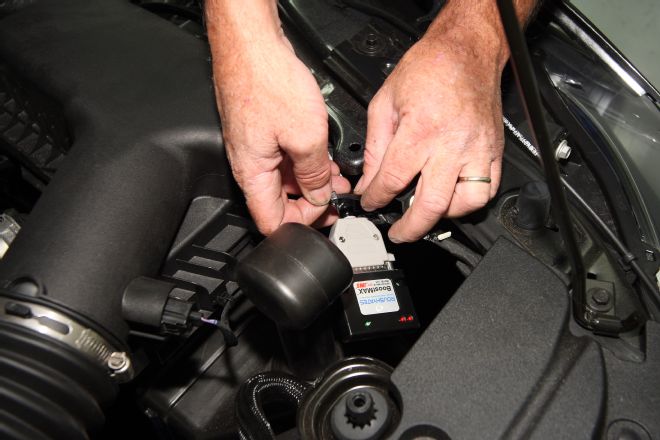
15. While at the front of the car, Junior also zip-ties the control module in place just behind the headlight. There is enough room with the wiring harness to allow several options for mounting the module, but behind the light seems like the best spot. It provides protection from moving components, including water and heat.
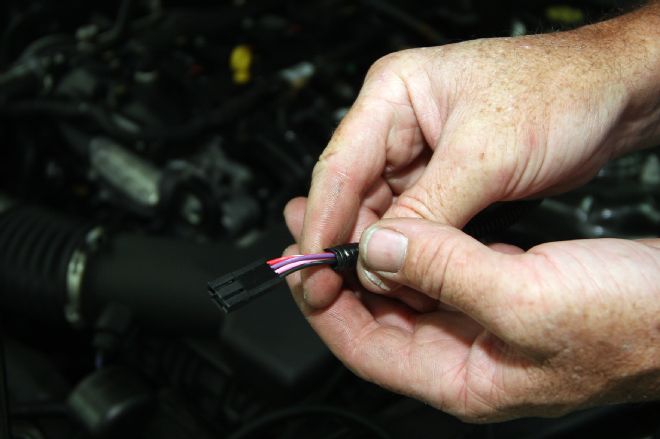
16. Finally, the last piece of the BoostMAX wiring harness is this four-pin connector for the boost control knob. It routes to the interior behind the dash and goes through a grommet hole in the firewall beneath the brake booster.
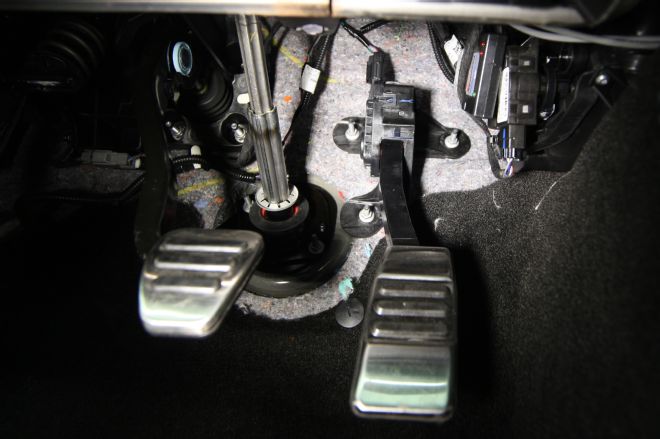
17. The additional boost provided by the BoostMAX can be set by this control knob; it plugs into the four-pin connector that was just run through the firewall. The zero setting essentially turns the BoostMAX off and returns the EcoBoost to OEM settings. On the other end of the range, the 100 setting (for 100 percent) pumps five additional pounds of boost to the combustion chambers, which is usually worth over 50 hp at the rear wheels. If you are operating at full boost, 93-octane gasoline is a must.
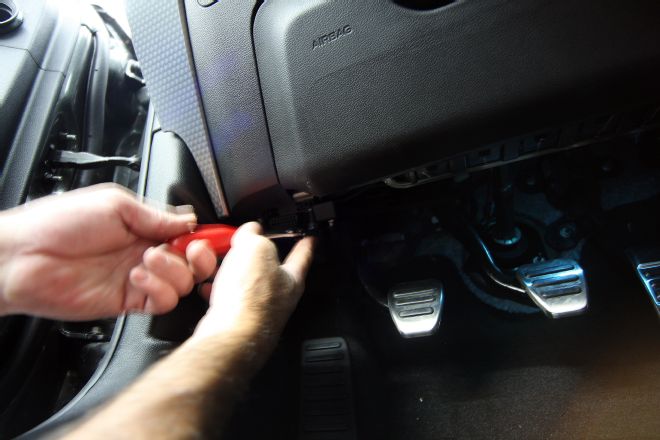
18. The control knob can be mounted in any number of locations, but Junior recommends using one of the two bolts that mount the ODB-II connector to mount the control knob just underneath the edge of the dash. This puts the control knob within easy reach yet out of the way. Any extra cable can be tucked behind the kick panel.
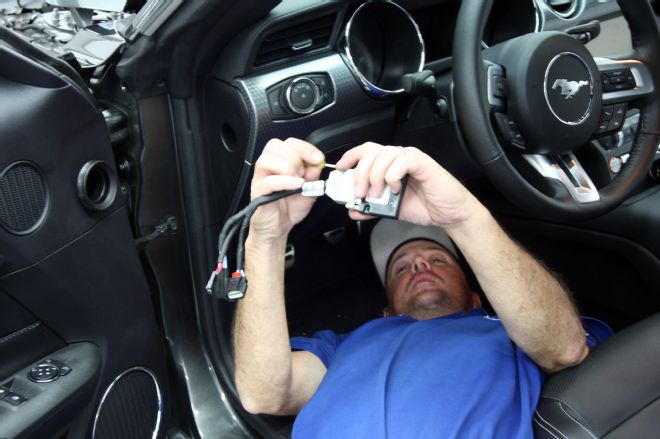
19. Junior then instaled the PedalMAX kit, which improves pedal feel by reducing lag in the drive-by-wire throttle system. The install is very simple, requires only a few minutes, and mounts completely underneath the dash.
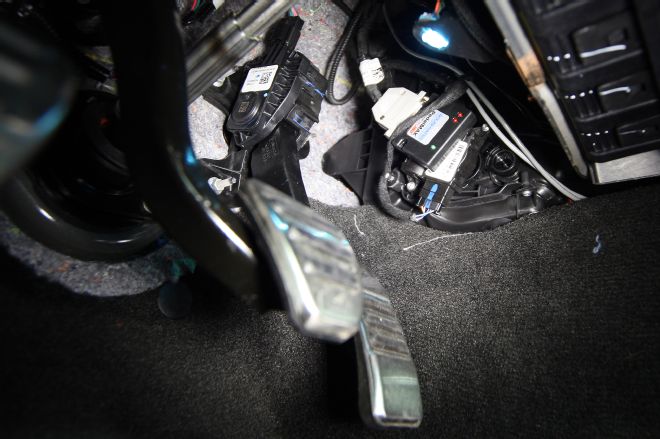
20. Here you can see the PedalMAX control module, which has been tied to the inner panel of the driver's footwell. The wiring harness has connections to route it inline with the throttle pedal. If you are using it with the BoostMAX unit, there are also plugs to connect it to that too. Also, Junior stresses that nothing should be tied to the steering column or any moving components connected to the brake, throttle, or clutch.

21. Just above the throttle pedal you can see the plug for the computer-controlled throttle. The PedalMAX uses a male and a female plug to splice right into the system just like the BoostMAX does for the boost controls.
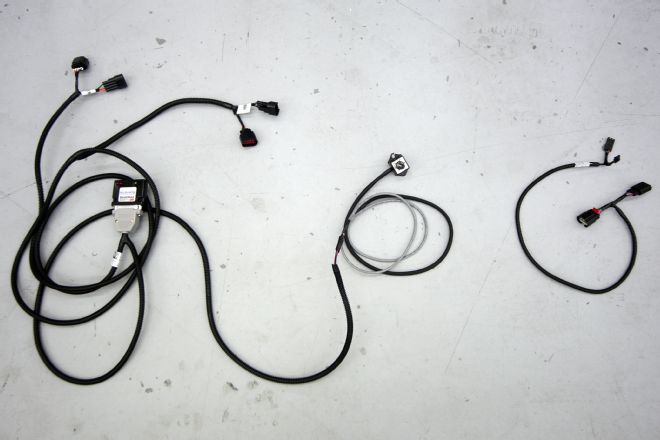
22. It can be a bit difficult to understand how the harness works and where everything plugs when mating the two systems, so we thought it would be easier with a couple photos. On the left is the wiring harness for the BoostMAX. You can see how the four-pin plug connects to the boost control knob in the center. If you are using just the BoostMAX system, that's all there is to it. The harness for the PedalMAX is on the right.
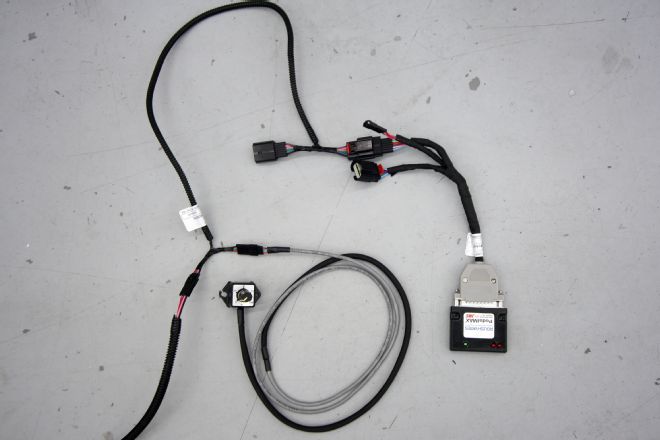
23. Pairing the PedalMAX harness to the BoostMAX is simple. First, unplug the boost control knob and plug the four-pin plug from the PedalMAX harness into it. The PedalMAX harness has a second four-pin plug for the boost control knob, and it has already been plugged in as you can see. The two larger plugs that are open are to splice the unit into the OEM electronic throttle controls. The last four-pin plug you see (near the control module) is for an included chip that dials back some of the aggressiveness of the PedalMAX. Junior says that his customers never use the chip, instead preferring the full-go feel provided by the PedalMAX system.
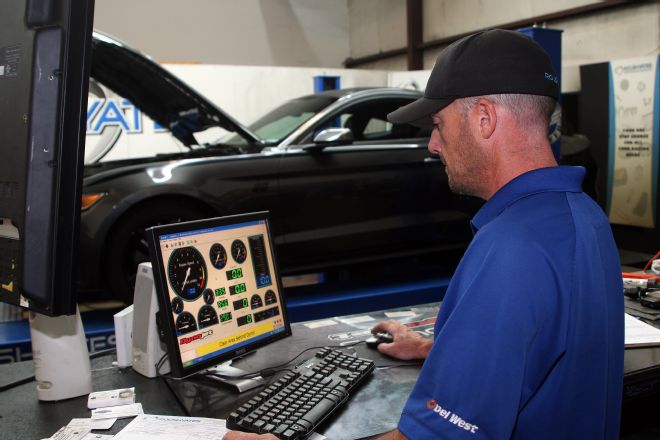
24. Before sending this Mustang out into the world, Junior put it back on the chassis dyno to test the results. We’re talking an easy 54 hp and 66 lb-ft of torque gain at the rear wheels.
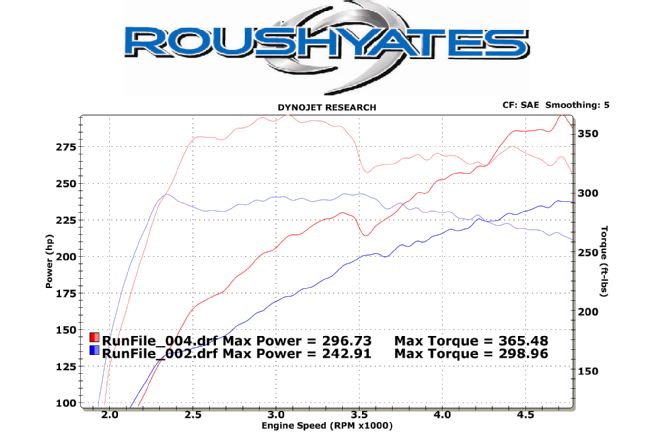
Q&A With Doug Yates
Doug Yates is the son of racing legend Robert Yates and the president of Roush & Yates Racing Engines. While we were at his facilities in Mooresville, North Carolina, he was kind enough to answer a few questions about his company's foray into street performance and what we might expect in the future.
Roush Yates has a very successful history in auto racing. Why step out of your comfort zone and make the push into street performance?
Since 2004, Roush Yates has built engines for dozens of NASCAR teams in Sprint Cup, Xfinity, and Camping World Trucks while capturing our 100th Sprint Cup and 100th Xfinity Series wins in 2015. RYE has one Sprint Cup Championship and three Xfinity Series Championships.
There is a lot of crossover between racing and street performance. We race-prep the engines for a number of Continental Tire Sportscar Challenge and Pirelli World Challenge teams. These engines are very similar to the engine you have in your EcoBoost vehicle. The Prototype V-6 EcoBoost engine that races in the IMSA United Sportscar Series is made of 70 percent production parts. The core of what we do is take the production-based engines and sculpt them into top-performing race engines. We would like to share this expertise with the performance enthusiasts around the world by taking our experience and knowledge to the street with the Roush Yates Power & Performance Lines.
What advantage does Roush Yates bring to the table that separates these products from others on the market?
Roush Yates' mission is winning through demonstrated quality and reliability. JMS and Hellwig (RYPP partners) bring the same premium to the street performance world and share our vision of world-class innovation for racing and performance products.
Roush Yates has a strong team of calibration experts for engine control management systems. Our team has extensive OE experience and racing performance experience. We were able to bridge our racing experience into the street performance market through our work with the EcoBoost engines. We understand the needs of the engine and how to maximize the performance. We can give the engine what it needs to perform at its best.
Roush Yates has a strong racing heritage at the highest levels of auto racing, making us a great fit for teaming up with companies like JMS Chip and Hellwig Products. Our company has over 180 employees who are dedicated to delivering power, performance, and reliability. We have taken our experience and knowledge from building engines and put that into developing world-class street performance products like Roush Yates by JMS BoostMAX and PedalMAX along with Roush Yates by Hellwig sway bars.
Engine electronics and sway bars don't seem to have an obvious connection. Is there one we are missing? Is there a theme for the types of products we may see in the future?
Street performance enthusiasts are always asking for more horsepower, more torque, and better handling. The product lines we are introducing will deliver and impress the most demanding enthusiasts. The Roush Yates by JMS and Roush Yates by Hellwig product lines cover a large offering, including Raptors, F-150s, and Mustangs, including the new 2.3L EcoBoost and 5.0L. We have witnessed stock EcoBoost engines increase by over 75 hp.
The street performance market has also been demanding better-handling vehicles with that increased horsepower, so we partnered with Hellwig to create sway bars that will improve handling and performance.